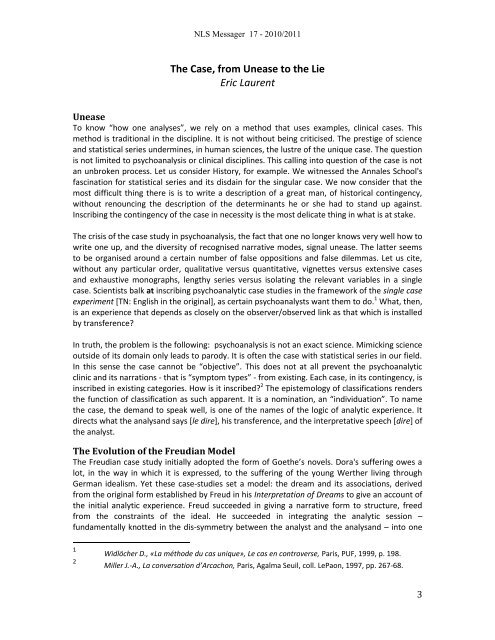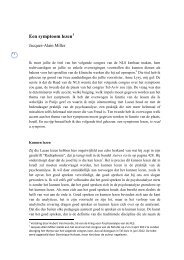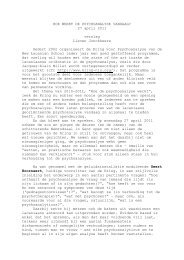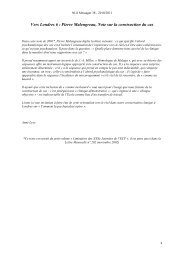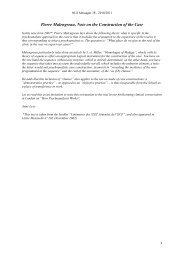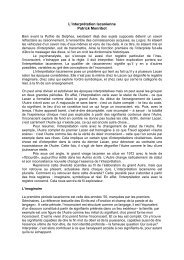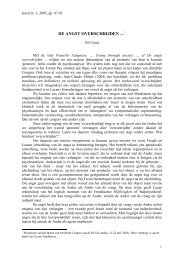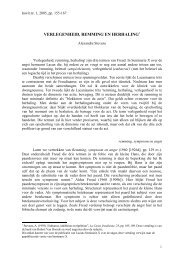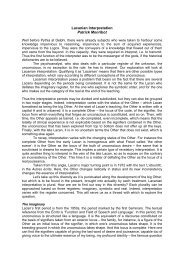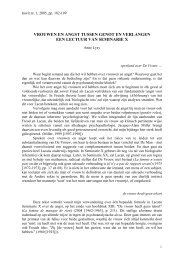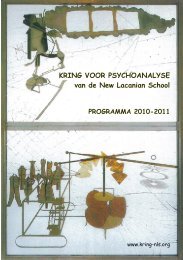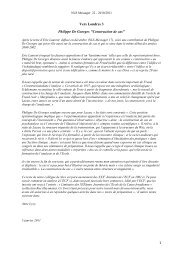Vers Londres 2 Eric Laurent, « Le cas, du - Psychoanalyse Lacan ...
Vers Londres 2 Eric Laurent, « Le cas, du - Psychoanalyse Lacan ...
Vers Londres 2 Eric Laurent, « Le cas, du - Psychoanalyse Lacan ...
You also want an ePaper? Increase the reach of your titles
YUMPU automatically turns print PDFs into web optimized ePapers that Google loves.
NLS Messager 17 - 2010/2011<br />
The Case, from Unease to the Lie<br />
<strong>Eric</strong> <strong>Laurent</strong><br />
Unease<br />
To know “how one analyses”, we rely on a method that uses examples, clinical <strong>cas</strong>es. This<br />
method is traditional in the discipline. It is not without being criticised. The prestige of science<br />
and statistical series undermines, in human sciences, the lustre of the unique <strong>cas</strong>e. The question<br />
is not limited to psychoanalysis or clinical disciplines. This calling into question of the <strong>cas</strong>e is not<br />
an unbroken process. <strong>Le</strong>t us consider History, for example. We witnessed the Annales School's<br />
fascination for statistical series and its disdain for the singular <strong>cas</strong>e. We now consider that the<br />
most difficult thing there is is to write a description of a great man, of historical contingency,<br />
without renouncing the description of the determinants he or she had to stand up against.<br />
Inscribing the contingency of the <strong>cas</strong>e in necessity is the most delicate thing in what is at stake.<br />
The crisis of the <strong>cas</strong>e study in psychoanalysis, the fact that one no longer knows very well how to<br />
write one up, and the diversity of recognised narrative modes, signal unease. The latter seems<br />
to be organised around a certain number of false oppositions and false dilemmas. <strong>Le</strong>t us cite,<br />
without any particular order, qualitative versus quantitative, vignettes versus extensive <strong>cas</strong>es<br />
and exhaustive monographs, lengthy series versus isolating the relevant variables in a single<br />
<strong>cas</strong>e. Scientists balk at inscribing psychoanalytic <strong>cas</strong>e studies in the framework of the single <strong>cas</strong>e<br />
experiment [TN: English in the original], as certain psychoanalysts want them to do. 1 What, then,<br />
is an experience that depends as closely on the observer/observed link as that which is installed<br />
by transference?<br />
In truth, the problem is the following: psychoanalysis is not an exact science. Mimicking science<br />
outside of its domain only leads to parody. It is often the <strong>cas</strong>e with statistical series in our field.<br />
In this sense the <strong>cas</strong>e cannot be “objective”. This does not at all prevent the psychoanalytic<br />
clinic and its narrations - that is “symptom types” - from existing. Each <strong>cas</strong>e, in its contingency, is<br />
inscribed in existing categories. How is it inscribed? 2 The epistemology of classifications renders<br />
the function of classification as such apparent. It is a nomination, an “indivi<strong>du</strong>ation”. To name<br />
the <strong>cas</strong>e, the demand to speak well, is one of the names of the logic of analytic experience. It<br />
directs what the analysand says [le dire], his transference, and the interpretative speech [dire] of<br />
the analyst.<br />
The Evolution of the Freudian Model<br />
The Freudian <strong>cas</strong>e study initially adopted the form of Goethe’s novels. Dora's suffering owes a<br />
lot, in the way in which it is expressed, to the suffering of the young Werther living through<br />
German idealism. Yet these <strong>cas</strong>e-studies set a model: the dream and its associations, derived<br />
from the original form established by Freud in his Interpretation of Dreams to give an account of<br />
the initial analytic experience. Freud succeeded in giving a narrative form to structure, freed<br />
from the constraints of the ideal. He succeeded in integrating the analytic session –<br />
fundamentally knotted in the dis-symmetry between the analyst and the analysand – into one<br />
1<br />
2<br />
Widlöcher D., «La méthode <strong>du</strong> <strong>cas</strong> unique», <strong>Le</strong> <strong>cas</strong> en controverse, Paris, PUF, 1999, p. 198.<br />
Miller J.-A., La conversation d’Arcachon, Paris, Agalma Seuil, coll. <strong>Le</strong>Paon, 1997, pp. 267-68.<br />
3


